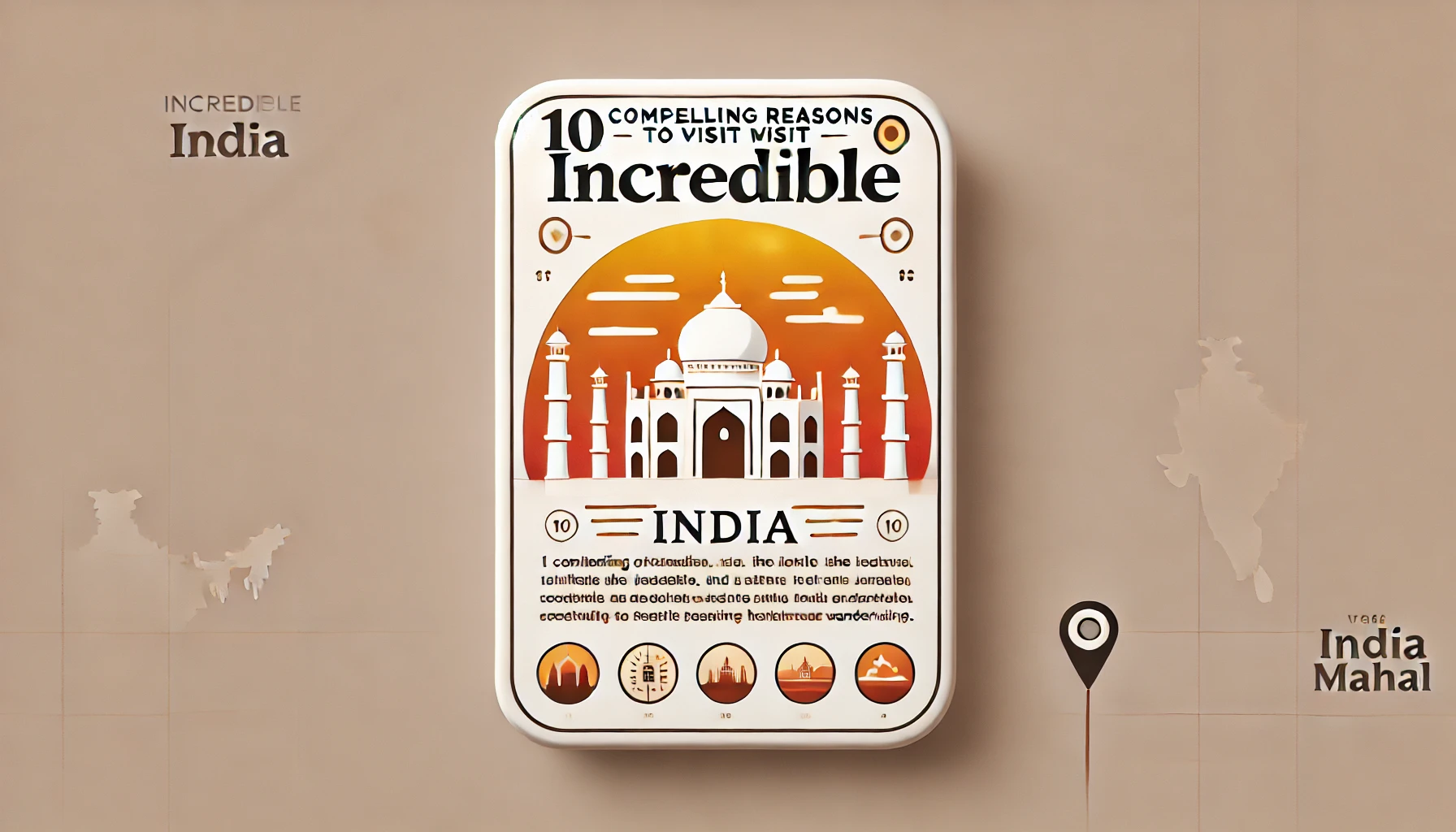India, often referred to as Incredible India, is a land of unparalleled diversity and charm. From snow-capped mountains to sun-kissed beaches, ancient temples to bustling markets, and serene villages to vibrant cities, India offers a myriad of experiences that captivate the heart and soul. If you’re contemplating your next travel destination, here are ten compelling reasons why India should be at the top of your list.
1. Rich Cultural Diversity
India is a melting pot of cultures, languages, and traditions. With over 2,000 ethnic groups and more than 1,600 dialects, the cultural tapestry of India is as vast as it is vibrant.
Experience Vibrant Festivals
- Diwali: Known as the Festival of Lights, Diwali symbolizes the victory of light over darkness.
- Holi: The festival of colors celebrates love, joy, and the arrival of spring.
- Navratri: A nine-night festival honoring the divine feminine energy.
Explore Diverse Traditions
- Music and Dance: Enjoy classical dances like Bharatanatyam and Kathak, and music forms like Hindustani and Carnatic.
- Art and Literature: Discover rich artistic heritage through paintings, sculptures, and literary works.
2. Historical Landmarks and Heritage Sites
India’s history spans thousands of years, leaving behind a wealth of historical monuments and UNESCO World Heritage Sites.
Iconic Monuments
- Taj Mahal, Agra: A symbol of eternal love and one of the Seven Wonders of the World.
- Qutub Minar, Delhi: The tallest brick minaret globally, showcasing Indo-Islamic architecture.
- Hampi, Karnataka: Ruins of the Vijayanagara Empire, offering a glimpse into ancient grandeur.
Ancient Temples
- Khajuraho Group of Monuments: Renowned for their intricate carvings and sculptures.
- Konark Sun Temple: A 13th-century temple dedicated to the sun god, Surya.
3. Diverse Natural Landscapes
India’s geography is incredibly diverse, offering a range of natural wonders.
Breathtaking Destinations
- Himalayan Mountains: Ideal for trekking, mountaineering, and experiencing spiritual retreats.
- Kerala Backwaters: Serene waterways perfect for houseboat cruises and relaxation.
- Thar Desert: Experience camel safaris and traditional desert life.
Pristine Beaches
- Goa: Famous for its sandy beaches, water sports, and nightlife.
- Andaman and Nicobar Islands: Explore exotic marine life and coral reefs.
4. Culinary Delights
Indian cuisine is a flavorful journey that varies dramatically from one region to another.
Regional Specialties
- North Indian Cuisine: Enjoy dishes like butter chicken, biryani, and naan.
- South Indian Dishes: Savor dosa, idli, and spicy curries.
- Street Food: Try chaat, pani puri, and kebabs.
Culinary Experiences
- Cooking Classes: Learn to cook traditional Indian dishes.
- Food Festivals: Participate in events celebrating regional cuisines.
5. Spiritual Journeys
India is the birthplace of major religions like Hinduism, Buddhism, Jainism, and Sikhism.
Sacred Sites
- Varanasi: One of the world’s oldest inhabited cities, situated on the banks of the Ganges.
- Bodh Gaya: Where Buddha attained enlightenment.
- Golden Temple, Amritsar: The holiest shrine in Sikhism.
Yoga and Meditation
- Rishikesh: Known as the Yoga Capital of the World.
- Ashrams and Retreats: Places for spiritual learning and self-discovery.
6. Art and Handicrafts
India’s rich tradition of arts and crafts reflects its cultural heritage.
Cultural Treasures
- Handloom Textiles: Including Banarasi silk and Kanchipuram sarees.
- Handicrafts: From intricate jewelry to pottery and wood carvings.
- Folk Art: Madhubani paintings, Tanjore art, and more.
Shopping Experiences
- Local Markets: Shop for souvenirs in bustling bazaars.
- Craft Villages: Visit places like Raghurajpur to see artisans at work.
7. Wildlife and Biodiversity
India’s diverse ecosystems are home to an array of wildlife species.
Wildlife Experiences
- Ranthambore National Park: Spot Bengal tigers in their natural habitat.
- Kaziranga National Park: Known for one-horned rhinoceroses.
- Periyar Wildlife Sanctuary: Famous for elephants and rich birdlife.
Eco-Tourism
- Sunderbans: Explore the largest mangrove forest in the world.
- Western Ghats: A biodiversity hotspot and UNESCO World Heritage Site.
8. Adventure Activities
For thrill-seekers, India offers a multitude of adventure sports.
Exciting Options
- River Rafting in Rishikesh: Navigate through challenging rapids.
- Paragliding in Bir Billing: Experience the thrill of flying.
- Scuba Diving in Andaman: Discover underwater marine life.
Mountain Adventures
- Trekking: Trails like the Valley of Flowers and Roopkund.
- Skiing: In destinations like Gulmarg and Auli.
9. Warm Hospitality
Indian hospitality is renowned worldwide, making visitors feel truly welcome.
Homestays and Local Interactions
- Stay with Local Families: Experience authentic Indian life.
- Community Tours: Engage with local customs and traditions.
Cultural Exchange
- Traditional Welcome: Participate in rituals like aarti and tilak.
- Culinary Sharing: Enjoy home-cooked meals and learn family recipes.
10. Affordable Travel
India offers a range of options suitable for all budgets.
Value for Money
- Economical Accommodations: Hostels, guesthouses, and budget hotels.
- Affordable Transportation: Extensive train and bus networks.
- Street Markets: Shop for goods at reasonable prices.
Luxury Experiences at Lower Costs
- Five-Star Hotels: Enjoy luxury stays at competitive rates.
- Fine Dining: Savor gourmet meals without overspending.
Frequently Asked Questions
Q: What is the best time to visit India?
A: The ideal time to visit India is between October and March when the weather is pleasant across most regions.
Q: Do I need a visa to travel to India?
A: Yes, most travelers require a visa. You can apply for an e-Visa online before your trip.
Q: Is India safe for solo travelers?
A: India is generally safe, but it’s important to stay vigilant, especially in crowded places and at night. Solo travelers should take standard precautions.
Q: What languages are spoken in India?
A: Hindi and English are widely spoken, but India has 22 officially recognized languages and hundreds of dialects.
Q: What currency is used in India?
A: The Indian Rupee (INR) is the official currency. It’s advisable to carry some cash, especially in smaller towns.








